SPINSIGHTinsights
The revolution in table tennis - Finally understand what is really happening!
You've always wondered...
- What is spin & speed all about?
- What are the differences in stroke quality between individual players?
- How much spin do you create with topspin and how important is the serve?
- What influence does the size of the hall have?
- What role does the material play?
We finally have the first answers to many questions!
First spin & speed values in practice
at topspin
With our SPINSIGHT technology, statements can finally be made about all strokes in reality.
We have examined the most important attacking strokes of table tennis in a first study.
The results we cover below concern topspin against block and against undercut.
How much spin in revolutions per second (rps) do professionals achieve on average?
125 rps for female pros, and 140 rps for male pros.
How much spin do amateur players achieve?
Very variable, but only 50% of all players reach 100 rps.
Is there a correlation between TTR points and spin (rps)?
On average, the more TTR the more spin achieved.
Is more spin (and speed) generated on forehand or backhand topspin? Against top or against undercut?
Players usually have individual strengths and weaknesses and the differences can be very large. On average, however, all four types of topspin (VH and RH, against OS and US) are of equal value and many of the best players also achieve the same amount of spin with all four variants.
Below you can see the average value of 10 topspins with as much spin as possible. A total of 200 professionals (national players playing international competitions, U10 to adults, women and men). This is the graph for forehand topspin vs block. The graphics for forehand against undercut and for backhand against block and against undercut look the same.
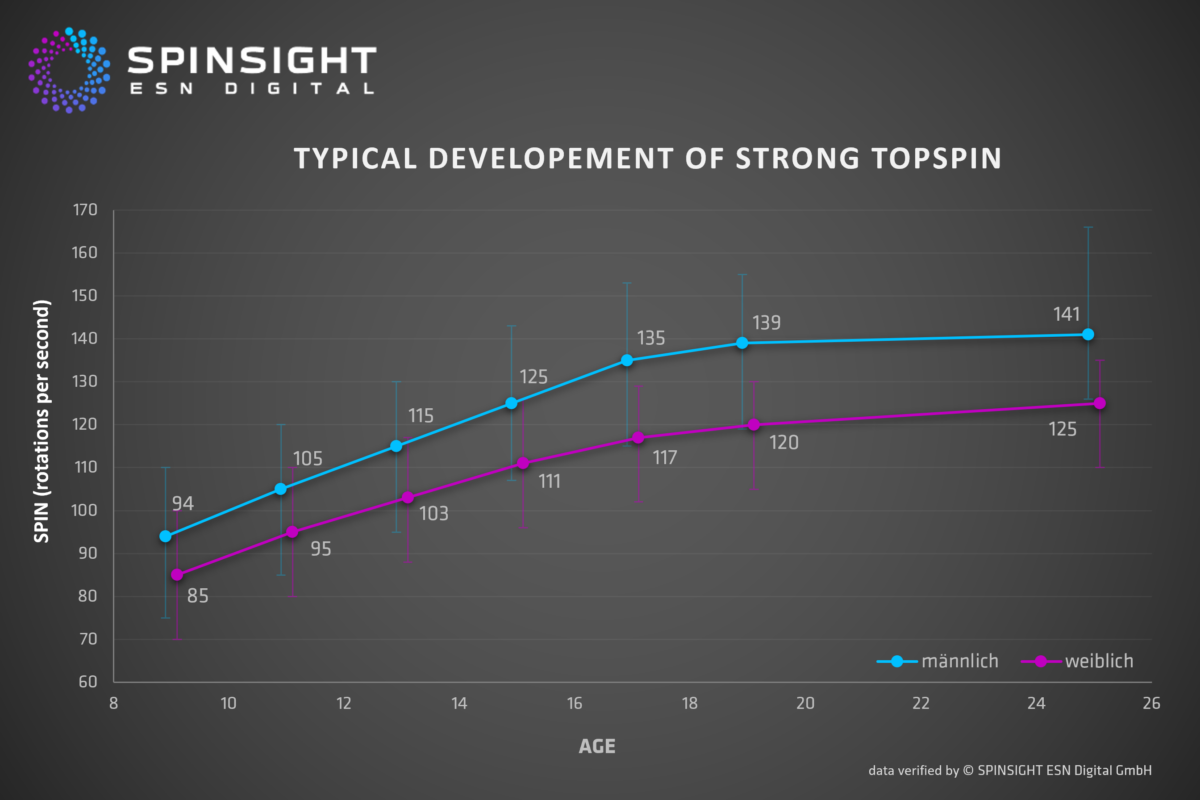
Interpretation statistics:
- Across all players, the averages for all 4 topspin variations (VH/RH, vs Block/US) are the same! Despite very different movements and conditions, the end result is the same. No fundamental advantage or disadvantage of any of the techniques.
- Individually big differences, almost every player individual strengths and weaknesses; what you train the most is the best, so for many kids/beginners VH vs block is the best stroke and against undercut is less quality
- Best players, however, usually have no weaknesses, often all four strokes somewhat the same or a particular strength
- Adult pro man averages 140 and woman 125 rps. Overall men more than women in young people the older the more. So in addition to technique, strength also plays an important role in topspin.
- At the top there are specialists who average 170 rps in men and occasionally approach 200 rps. The best women manage over 140 rps (like the average of the men) and occasionally over 150 rps.
- The best 15 year olds already manage the adult averages.
Below we see the maximum value of 10 topspins with forehand against block (ball bucket) with as much spin as possible. Andro Kids Open participants, 220 players in total (7-19 years, 700-2000 TTR).
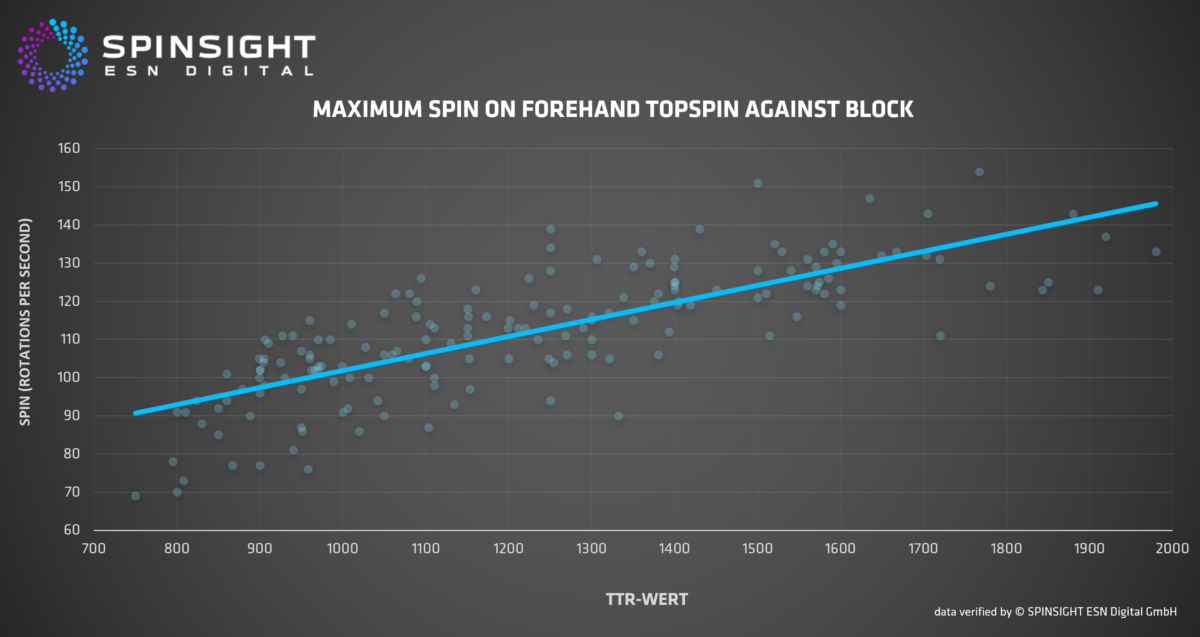
Interpretation statistics:
- At the andro Kids-Open regional squads and club players were measured. (here not the average of 10 maximum strokes but the absolute maximum was evaluated). Per age group about 10% below the average of the measured national squads, and it spreads out much more. Basically, however, one sees the same tendencies as with the professionals.
- Within an age group there is a correlation with the TTR points - the higher the more!
Are the SPINSIGHT data already being used in sports science?
In addition to our own studies, we also collaborate with other scientists. For example, the Leipzig Institute for Applied Training Science is currently conducting a study on various topspins with German national players, and we are also planning a collaboration with the German Sport University in Cologne on talent identification and development, and a thesis on the quality of serves of youth national players is in the works. And there is also a lively exchange with many professional athletes.
How many revolutions do professionals manage on topspin?
Male professional players reach a peak of up to 200 revolutions per second (rps), and women occasionally 150 rps. On average, however, male pros achieve 140 rps and women 125 rps. Overall, it can be said that men tend to build up more spin than women and that older youngsters achieve higher values than younger ones. From this it can be deduced that, in addition to technique, power is therefore also an important factor in topspin. And yet the best 15-year-olds already manage the average values of adults.
Is it decisive whether you play the topspin with the forehand or with the backhand?
In fact, the average values for the four topspin variants - i.e. forehand, backhand, against block or undercut - were the same across all professional players! Despite the very different movements and conditions of these variants, the same revolution numbers come out in the end on average. This means that there is basically no advantage or disadvantage of any of the techniques. In principle, one can achieve the same stroke quality. Individually, of course, we could see differences - almost every player has his own strengths or weaknesses. Among the best players this rarely happens, but with these players all four strokes are more or less the same. With amateurs or younger players, on the other hand, you see greater differences. The best shot is often the one that is practiced the most - for children and beginners, this is usually forehand versus block. Here, the backhand values tend to be worse, which shows that, at least for us, many learn the backhand later.
How great is the variance of topspins among amateur players?
SPINSIGHT examined amateur players from seven to 79 years of age and of all performance classes. Pretty much everything from 50 to 150 rps was included. About half of the players measured failed to reach 100 rps and 90% stayed below 125 rps. The 10% who managed more, however, then always showed a weakness in one of the other categories of the performance test, for example in reaction, endurance, footwork speed, serving or other hitting techniques. Professionals, on the other hand, were also very successful in the other categories.
Can parameters be identified on which it depends with how many revolutions an amateur player plays his topspin?
In the context of the andro Kids Open, SPINSIGHT measured regional squad and club players, whereby we did not evaluate the average of ten maximum strokes, but the absolute maximum. This is per age group about 10% below the average of the measured national squad players and it spreads out much more. In general, there is - within an age group - a correlation of the maximum rotations with the height of the TTR value: The higher this is, the more rotations are measured. Even if you sort all participants of the Kids Open by TTR value, you can see a correlation with the spin values. Basically, the better the player is, the more revolutions his topspin has.
What about non-offensive game systems whose success does not necessarily depend on good topspin?
These fall under the exceptions, which can certainly be observed. For example, there are players who can't manage more than 110 rps with 1800 TTR points. This could be, for example, a defensive player who never attacks. And in the same way you can find players who with 800 TTR points already reach more than 110 rps. This could be a strong man with a good arm stroke, but who still has little control. So such exceptions are mostly explained by individual strengths and weaknesses.
What is the lesson to be learned from all these results?
Basically, table tennis is a sport that requires many different skills. And of course, of these, one should avoid and improve those that are more of a weakness and use more in the game those that belong to one's strengths. However, topspin is one of the most important skills in modern table tennis - and as you can see from the data, there is a great correlation with playing strength. So the lesson to be learned is that it's definitely worth improving your topspin.

TT Physics: Spin & Speed
during the ball flight
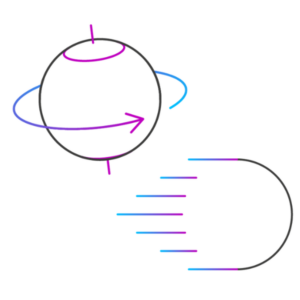
How much spin & speed is possible?
Up to 200 rps (revolutions per second) and 150 km/h can be achieved by the best players.
What effect do Spin & Speed have on the trajectory?
At the same speed, higher spin results in a more curved trajectory.
How do spin and speed change during ball flight?
Over a distance of 3m (which is approximately the distance between the ball hitting the club and hitting the table), the ball loses about 35% of its speed, but only 5% of its spin.
How does the ball spin?
The ball rotates during the entire flight around an axis, which is a combination of
- Top/bottom cut
- Sidespin (left/right)
- Cross spin (left/right)
How much spin & speed is possible?
The spin is the component that makes TT so special - interesting and complex at the same time. 200 revolutions per second is an enormous amount! By way of comparison, the tires of a sports car traveling at 350 km/h rotate 50 times per second - as much as the TT ball achieves with an average counterattack. This is made possible by the small diameter of the ball and the special nature of the TT rubbers.
What effect do Spin & Speed have on the trajectory?
The so-called Magnus force causes the ball's trajectory to curve in spin direction. With undercut balls hit high in the air, you can even create a loop (video looping). The trajectory can be seen clearly especially with balls hit from far away, e.g. with sidespin (video Hao Shuai) or with rotation-rich balloon defense balls (video Balloon Defense - here you can see in bird's eye view how the ball goes out of the table and then spins back into the table). But you can also use the effect of the trajectory at short distances (video Trickshot). In practice, this is especially relevant for topspin. Because the trajectory is curved more downward, you can play even very fast balls over the net in a controlled manner and still hit the table. The greater the ratio between spin and speed, the more curved the trajectory, at least in the range relevant for table tennis.
How do spin and speed change during ball flight?
Due to air resistance, the ball loses spin and speed during flight. However, the friction losses are significantly higher for speed than for spin. The size and weight of the ball play an important role here. Since the 40mm ball is not only bigger but also heavier than the 38mm ball, the differences during the flight are not that big and one achieves almost the same spin and speed (however, the mainly material-related differences can be seen "after the bounce on the table"). The typical length of the ball flight during topspin, i.e. the distance between the point of impact of the ball on the racket and the point of impact on the opposite half of the table, is approx. 3m. Over this distance the ball loses about 35% speed, but only 5% spin. A topspin with 100 rps therefore still has 95 rps when it hits the table. If the topspin has 100 rps, it hits the table with only 65 rps.
How does the ball spin?
If we imagine that the ball lies on the zero point in a three-dimensional coordinate system, then the X, Y and Z axes are three independent axes of rotation (see statistics). In practice, the ball always spins around exactly one axis during flight, which is a combination of the three axes X, Y and Z, or top/bottom, sidespin (left/right) and crossspin (left/right). In Spinsight, we show the spin in the direction of flight, as seen when looking at the ball from behind. Theoretically, the ball can spin around all axes at the same rate during play. In practice, however, the highest spin values are usually achieved with topspin, since the downward curved trajectory gives you the largest hitting range. A special feature is crossspin, whose trajectory is rather stable and whose effect only becomes apparent when it hits the table and, above all, the opponent's racket. Cross spin is still quite unknown and is therefore only used consciously by very few players, but it develops its effect right up to the absolute top of the world.
How much spin & speed is possible?
Anything from 0-200 rps and 0-150 km/h is possible - and sometimes at a distance of less than 3m. This incredible speed and the precision needed to successfully return the ball make table tennis a unique sport that stimulates both body and mind. So it is not surprising that table tennis is a health sport that is used, among other things, in the therapy of Alzheimer's disease (https://www.mytischtennis.de/public/buntes/4585/tischtennis-als-therapiemethode-bei-alzheimer, www.ping4alzheimer.com) and Parkinson's disease (https://www.pingpongparkinson.de/) and also ensures better grades at school (https://www.tischtennis.de/news/tischtennis-macht-schlau.html), especially in mathematics.
Examples of typical spin and speed values of different stroke types:
| Spin | Speed | |||||
| Type of beat | low | medium | high | low | medium | high |
| Counter | 40 | 50 | 60 | 20 | 30 | 40 |
| Topspin | 60 | 100 | 150 | 30 | 50 | 70 |
| Shove | 20 | 40 | 60 | 10 | 20 | 30 |
| Defense | 40 | 70 | 100 | 10 | 20 | 30 |
| Shot | 50 | 70 | 90 | 40 | 60 | 80 |
| Short serve with undercut | 20 | 40 | 60 | 5 | 10 | 15 |
| Long serve | 30 | 50 | 70 | 15 | 25 | 35 |
What effect do Spin & Speed have on the trajectory?
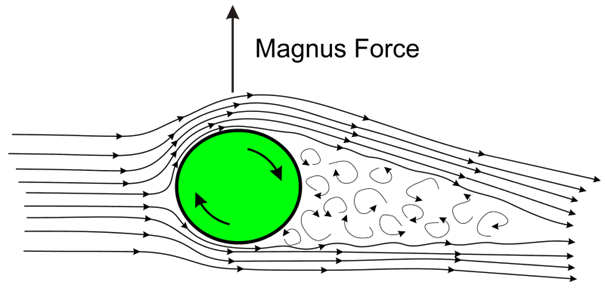
(Image source: Wikipedia Magnus Effect)
The picture shows a ball flying from right to left with undercut. Due to the ball rotation, the air directly below the ball is pressed against the air flowing in the opposite direction (high pressure) and directly above the ball, the air flowing in the opposite direction is accelerated in the same direction (low pressure), whereby the Magnus force in this case acts upwards against the earth's gravitational force.
How do spin and speed change during ball flight?
In this series of pictures we see an exemplary progression of spin and speed during a topspin against block:
1. 126 rps and 63 km/h - shortly after the ball hits the racket.
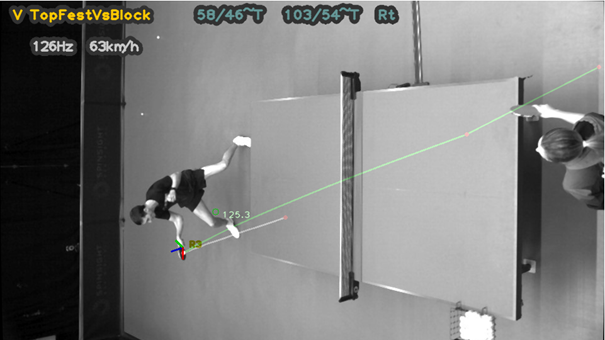 2. 124 rps and 52 km/h - after less than 1m the ball has already lost 11 km/h but only 2 rps
2. 124 rps and 52 km/h - after less than 1m the ball has already lost 11 km/h but only 2 rps
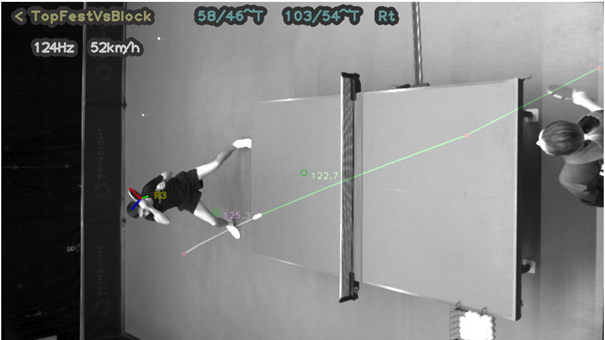
3. 122 rps and 45 km/h - after just under 2m, the ball in the example has 4 rps and 18 km/h less. Compared to the previous picture, the ball has lost 2 rps and still 7 km/h in the same period.
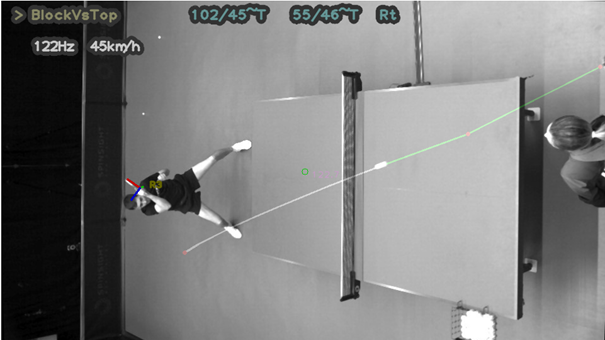
4. 120 rps and 41 km/h - just before hitting the table, the ball lost another 2 rps and 4km/h and a total of 6 rps and 22 km/h less than at the beginning.
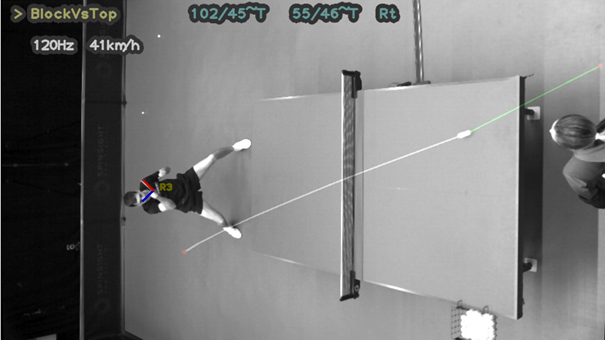
How does the ball rotate?
The following graphic shows the three axes of rotation in space: X - top/bottom spin, Y - sidespin and Z - cross spin:
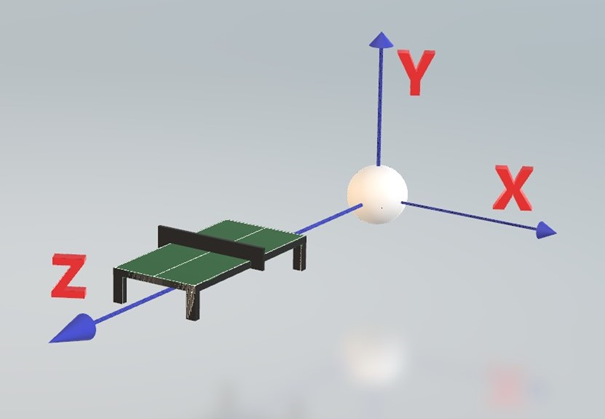
In visual terms, you can also imagine a futuristic car-helicopter hybrid. In the direction of travel, the wheels rotate with upper/lower spin, the propeller on the roof with sidespin and the steering wheel with cross-spin.
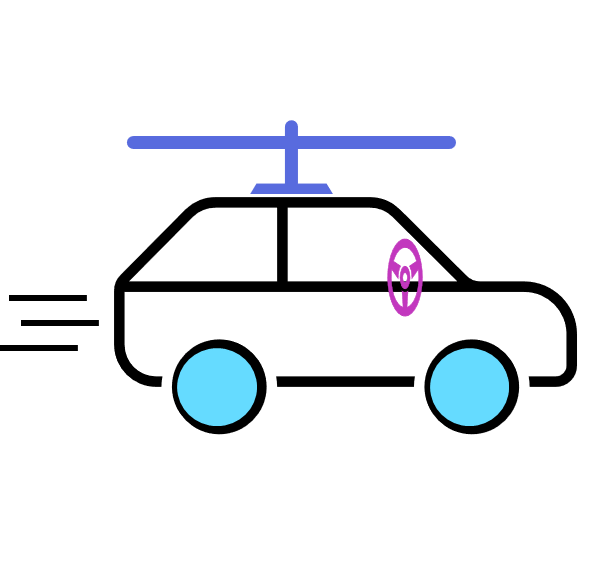
How much spin & speed is possible?
Who doesn't know it: a player serves slowly and the return player plays slowly into the net. Even with the pros, this happens again and again. Even small changes in spin have a big impact on the effect. Judging the spin correctly and finding the right response in a fraction of a second requires talent and a lot of training. The better you can do that, the more successful you usually play.
With the SPINSIGHT app, you can now measure the spin in your training super precisely for each stroke to better understand what's really happening and improve quickly.
The SPINSIGHT ball alone shows you the spin direction and amount thanks to its special, patented point structure. This is especially helpful for serve training, as the ball can change its spin every time it hits the table.
Maximum Power und Variation:
The more spin and speed you create, the more pressure you can put on your opponent. But it also opens up more possibilities for varying spin and speed. Especially on serve, there are real specialists who create completely different stroke qualities with the seemingly same movement. Variation is not only possible with the serve, but also with the return, push, block, topspin and every other stroke. Even small differences of just 20 rotations can have a huge effect and make the ball impossible to return without adjusting the stroke motion.
Try to increase your maximum spin and speed and then use your potential for a variable game! Perform skill tests regularly with the SPINSIGHT app to see and increase your maximum performance. Once you've mastered a stroke technique, look for variation drills in the SPINSIGHT app to unlock your full potential.
What effect do Spin & Speed have on the trajectory?
Due to the spin-related curvature of the trajectory, the topspin has the largest hitting range and can still be played in a controlled manner even at high speeds. The spin/speed ratio is the most important factor here.
Try to increase the spin with faster topspins. A spin/speed ratio of 2.5 already leads to good trajectories. Up to a ratio of 5 you can visibly increase the curvature of the trajectory. Spinny topspins with a ratio of more than 3 also cause the ball to kick and the trajectory to change after takeoff.
Do you have problems controlling your shot? Especially long balls are often difficult to shoot. A fast topspin is often a good alternative in such cases.
If you play with undercut, the trajectory reduces the hitting window considerably. Try to hit the ball as close as possible to the highest point of the trajectory or reduce the speed or increase the distance to the table to improve your chances.
How do spin and speed change during ball flight?
Since the ball loses its speed faster than its spin in flight, it is more efficient to play spin-oriented.
As an attacking player, you should also consider taking the ball earlier. This will reduce the distance to the opponent and your shot will arrive at a higher speed. Even if you play slower, the opponent often has less time to react. In defense, a greater distance to the table helps you. Even hard shots are not so fast until they reach you and you often have time to get into a good position with several steps. However, be alert and ready to get back to the table quickly on stop balls. Also, when counter-attacking from a distance, make sure to play with a higher trajectory to create the necessary length.
It is often recommended to let the ball "spin out". However, as we have seen, the ball loses almost no spin and the lower speed actually tends to increase the spin/speed ratio and thus the spin effect.
If you are not sure of the spin of the incoming ball (e.g. when hitting back), it can still help to let the ball bounce a little longer if you use the time to read the spin and position yourself better to the ball. Once you have read the spin and have a good position to the ball, you can put your opponent under time pressure if you take the ball as early as possible and increase your hitting field if you play the ball at the highest point of its trajectory.
How does the ball spin?
360° around three different axes and, in addition, any combination of these three independent spin directions - the variety of possible spin directions is enormous and each requires the backstroker to make his own adjustments to the stroke. Most players use only a fraction of the possible spin directions in their game and thus do not exhaust their potential by far. Especially on serve, you can determine your own spin completely uninfluenced, since you don't have to react to your opponent's incoming ball. But also in the game there is more than just upper and lower cut.
With the Spinsight app, you can see the spin direction for each shot, in addition to spin and speed. Use the exercises in the app to master the different spins and reach your full potential. Once you've mastered the spin variations on serve, try adding side and cross spin variations on return and open rallies to make even the best players despair.
Here, too, variation plays a decisive role in addition to maximum quality. The principle of generating different spins with the same movement is typical. But it also works the other way around - there are sometimes many different techniques with which you can create the same spin.
Right spin can be easily generated with the backhand on serve, for example, but it also works with the forehand on the 2nd phase pendulum serve, tomahawk serve or stip serve. Now you can compare all techniques and see which one suits you best. Often there are surprises here. New techniques often feel unfamiliar. However, if a new technique gives you the same or even better results without a lot of training, it may be worthwhile to spend a little more time with it.
Many people always use the same mixture of side-undercut with a little bit of cross spin when serving. In order to increase the effect of the individual spin shots, it can be worthwhile to train the pure spin shots. Especially the cross spin is often only present in parts, if at all.
The app also shows you when the cross spin portion is predominant. Together with the Spinsight balls you can learn and master even this demanding spin. Since only very few players use this spin device, the effect is particularly strong and a conscious use of cross spin is particularly promising.
How much spin & speed is possible?
In this section we will show you records of man and machine. First, in these two videos, you'll see what happens when the ball is accelerated to over 1000 km/h:
Record Attempt Speed, Machine:
https://www.youtube.com/watch?v=YYNCGZCul1Q
https://www.youtube.com/watch?v=rk-6wHimbUs
https://www.youtube.com/watch?v=zIdxIQ4hVbk
What effect do Spin & Speed have on the trajectory?
In this sensational rally, Waldner plays two very high spin-rich balloon defense balls at the end. At the end of the video you can see particularly well from a bird's eye view how the ball at first even moves out of the table and then turns back in:
https://www.youtube.com/watch?v=A8IVASo0umU
The guys from Pongfinity show very clearly in their spin shots which flight curves are possible:
